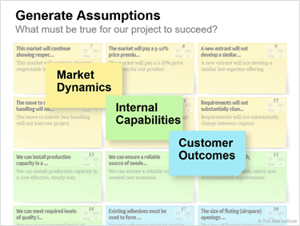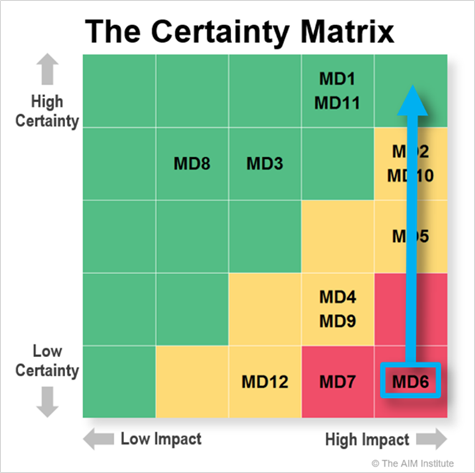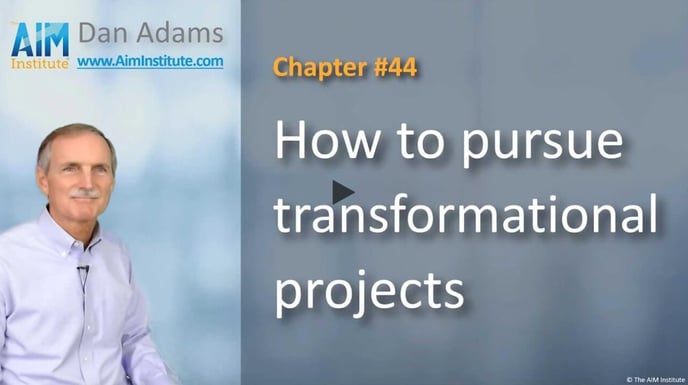Generate 6 Certainty Matrices to manage your Danger, Caution & Safe assumptions
 The AIM Institute developed Minesweeper de-risking methodology to efficiently defuse project landmines… or stop the project quickly if this can’t be done. Let’s imagine this example: Your company, Acme Composites, is in the business of blending recycled plastic and wood fibers to produce wood decking.
The AIM Institute developed Minesweeper de-risking methodology to efficiently defuse project landmines… or stop the project quickly if this can’t be done. Let’s imagine this example: Your company, Acme Composites, is in the business of blending recycled plastic and wood fibers to produce wood decking.
Someone has an interesting idea: What if you entered the corrugated packaging market? There might be some good value added, e.g. improved water resistance, stacking strength and abrasion resistance.
Using Minesweeper de-risking software and methods, the team begins by brainstorming all possible assumptions. These are phrased as, “in order for our project to succeed, it must be true that…” These assumptions are grouped into three categories:
- Market Dynamics: Assumptions about the market’s size, regulations that must be met, growth rate, and so on.
- Internal Capabilities: These are assumptions that are specific to your company, e.g. your ability to reach the market with sales & distribution, scale-up to full production, etc.
- Customer Outcomes: These are end-results for customers in this market segment. Some are required (they are already getting them) and some are desired (they’d like to get them).
There’s more to generating these: The software suggests dozens of typical assumptions so the team doesn’t overlook them. And the team also constructs something called a “consumption chain,” which helps them “think like the customer.”
Next the team rates each assumption for “impact” and “certainty.” If an assumption has high impact and low certainty, it registers on its Certainty Matrix as “Danger” (red). Less severe are “Caution” (yellow) assumptions.
The team’s goal is to vigorously investigate each assumption and drive it from uncertainty to certainty. In the Certainty Matrix, this usually means the assumption moves up from the red zone to the yellow zone and finally to the green (Safe) zone.

This Minesweeper process creates a total of six Certainty Matrices:
- Market Dynamics
- Required Outcomes
- Desired Outcomes
- Internal Capabilities
- Required Solutions
- Desired Solutions
Next your team creates a CheckPoint plan that focuses on each Caution (yellow) and Danger (red) assumption in these matrices. This plan will identify specific tasks that team members will pursue to drive these assumptions from uncertainty to certainty.
In some cases these tasks--a customer interview, a lab experiment, etc.--will give you information you were not hoping to hear. In other words, you reach "certainty," but you've become certain that the assumption you needed to be true for your project to succeed turned out to not be true. This means you've found a landmine. In Minesweeper software, you identify these as...
- Possible landmine
- Probable landmine
- Confirmed landmine
For more, download the AIM white paper, Innovating in Unfamiliar Markets, and view the Minesweeper Project De-risking video.
Also check out the 2-minute videos, How to pursue transformational projects and How to manage transformational projects, both part of the B2B Organic Growth video series by Dan Adams.
Keywords: Minesweeper, de-risking, certainty matrix, market dynamics, required outcomes, desired outcomes, internal capabilities, required solutions, desired solutions, Acme composites, landmine, brainstorm assumptions

